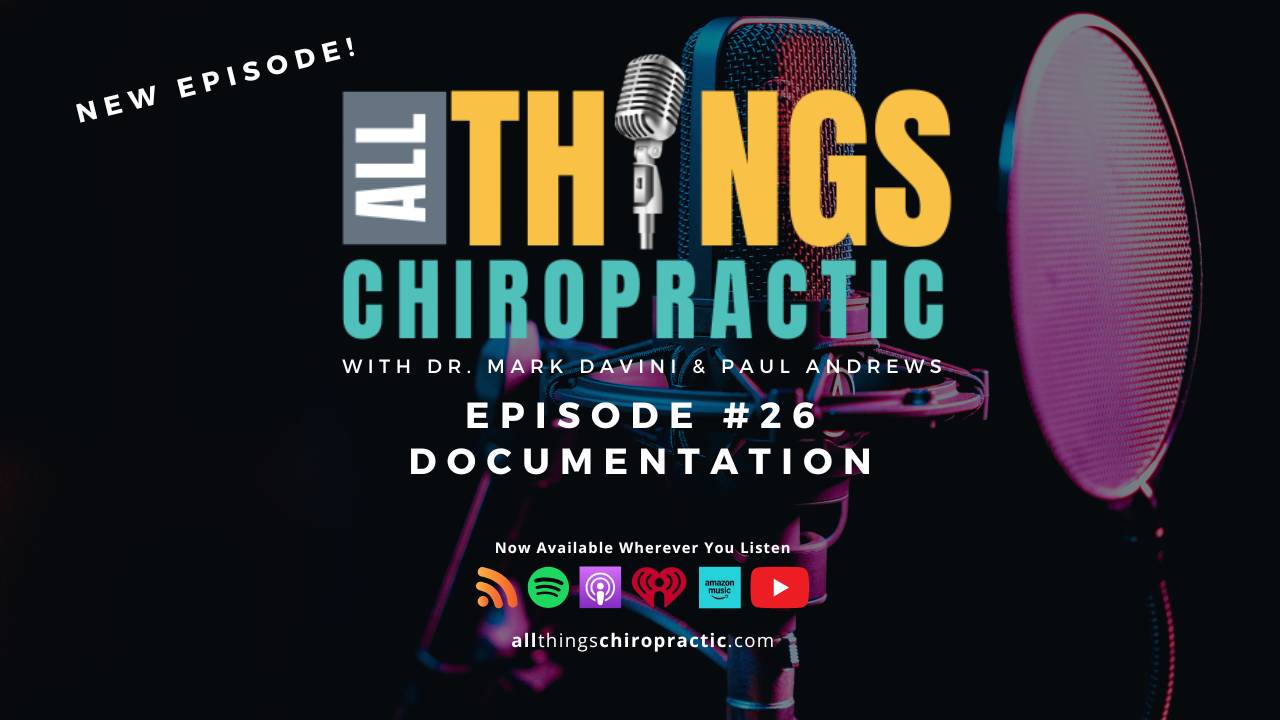All Things Chiropractic #35 - Social Media

🚨 Social media can be a game-changer for chiropractors—but it can also be a minefield.
In this episode of All Things Chiropractic, Paul Andrews and Dr. Mark Davini break down the good, the bad, and the risky side of using social platforms in practice. From boosting your marketing ROI and educating patients to navigating HIPAA landmines and online reviews, they don’t shy away from the tough stuff.
You’ll hear about:
-
🔒 Privacy pitfalls for patients and staff
-
📱 Key differences between Facebook, Instagram, and TikTok
-
⚡ The risks of posting adjustment videos
-
🛡️ Digital security best practices
And most importantly—the hosts share real-world strategies you can use right away: set clear office social-media policies, keep personal and professional accounts separate, get proper releases, protect minors’ identities, and handle complaints the right way.
If you’re ready to harness the power of social media without sacrificing compliance or patient trust, this episode is ...
All Things Chiropractic #26: Documentation

Episode 26: Cracking the Code on Documentation
In this lively episode of chiropractic podcast, All Things Chiropractic, hosts Paul Andrews and Dr. Mark Davini take on one of the most critical—and often dreaded—topics in chiropractic practice: documentation.
From the days of scribbled notes to today's exhaustive digital records, Dr. Davini shares how documentation has evolved and why it now sits at the heart of compliance, patient care, and getting paid. Together, the hosts tackle the pain points chiropractors face with third-party carriers and charting overload, while also offering smart strategies to make documentation work for you—not against you.
You'll get real-world tips on using scribes, improving note efficiency, and steering clear of risky habits like batch noting. Plus, a forward-looking peek into how AI might change the game. It’s a practical, punchy episode packed with wisdom, wit, and tools you can actually use.
All Things Chiropractic #24: CMS 1500 Claim Form – Boxes 14 & 15 Demystified

Think boxes 14 and 15 on the CMS 1500 claim form don’t matter? Think again. In this eye-opening episode, Paul Andrews and Dr. Mark Davini shine a spotlight on two of the most misunderstood sections of chiropractic billing—and why getting them right is more important than you think.
From rejected claims to audit nightmares, they break down the real-world consequences of skipping the details—and show you how to avoid the most common pitfalls. You'll learn:
✅ What these boxes actually mean (without the jargon)
✅ How to align clinical notes with claim data
✅ Why accuracy here can make or break your reimbursements
✅ Simple strategies to train your front desk or billing team
Whether you’re a seasoned doc or just getting started, this episode is packed with practical tips, a few laughs, and clarity you didn’t know you needed.
🎧 Tune in and take the guesswork out of chiropractic billing—because every box counts.
All Things Chiropractic Episode #16: The Claim Form

In this enlightening episode of All Things Chiropractic, hosts Paul Andrews and Dr. Mark Davini take a deep dive into one of the most essential—yet often overlooked—components of chiropractic billing: the CMS 1500 claim form.
While it might seem mundane at first glance, Paul and Mark reveal just how pivotal this form is to your practice's financial health and legal protection. With a focus on risk management, compliance, and billing education, they unpack the significance of each section of the form and explain how even minor errors can have major consequences.
Tune in as they answer critical questions:
-
Why is the CMS 1500 still used in the age of electronic submissions?
-
What’s the story behind that mysterious QR code?
-
How does the form connect to the National Uniform Claim Committee (NUCC)?
-
Why is the back of the form important, even in an electronic world?
-
What are taxonomy codes, and how do they define your specialty on a claim?
You'll also hear real-...
All Things Chiropractic - Episode #15: Risk Management

In this enlightening episode of All Things Chiropractic, hosts Paul Andrews and Dr. Mark Davini dive into the critical subject of risk management, cleverly titled "Risk is Not Just a Game." The discussion aims to demystify risk management for chiropractors, emphasizing its vital role in protecting your practice from unforeseen challenges.
The hosts explore various types of complaints that chiropractors might encounter, such as civil, regulatory, and criminal complaints, and discuss how each could impact your practice. Dr. Davini shares his approach to making risk management seamless in routine practice operations. They emphasize the importance of proper insurance coverage, from malpractice insurance to considering umbrella policies, to safeguard against financial pitfalls.
Listeners are guided through the nuances of handling complaints professionally and the significance of informed consent, illustrated by intriguing real-world cases. The conversation also touches on the responsibili...
All Things Chiropractic Episode #12: Manual Therapy Techniques

In this episode of All Things Chiropractic, hosts Paul Andrews and Dr. Mark Davini delve into the intricate world of chiropractic billing and coding of manual therapy techniques. With a hint of detective flair, they explore the evolution and challenges of coding, specifically focusing on the controversial code 97140. Gain insight into the historical changes initiated by the American Medical Association and how these changes impact billing practices for chiropractors and osteopaths alike.
Dr. Davini and Andrews discuss the implications of anatomical site restrictions and the ongoing struggle for chiropractors to receive fair compensation for manual therapy services. They shed light on the differences between chiropractic adjustments, mobilization, and manual therapy techniques, emphasizing the need for clear distinctions among different healthcare professions. This episode offers valuable perspectives on maintaining compliance while advocating for the profession's financial sustainabil...
All Things Chiropractic - Episode #5: Here Today, Gone Tomorrow

In this episode of All Things Chiropractic, hosts Paul Andrews and Dr. Mark Davini delve into the crucial topic of selling your chiropractic practice. They explore the importance of valuing your practice accurately and how to boost its value over time. The discussion sheds light on factors that influence practice valuation, such as patient volume, collections, and overheads. The hosts emphasize the significance of transferability, highlighting the challenges of personality-driven practices.
Listeners will gain insights into practical steps to enhance practice "saleability", from improving office aesthetics to optimizing staff efficiency. Andrews and Davini address common pitfalls, such as non-compliant coding practices, and provide tips on maintaining a financially healthy practice. They also explore the emotional aspects of selling a practice and encourage listeners to adopt a buyer's perspective when preparing their practice for sale.
Tune in for expert advice aimed at ensuring a s...
All Things Chiropractic - Episode 4: What has changed now that the dust has settled?

In this compelling episode of "All Things Chiropractic," hosts Paul Andrews and Dr. Mark Davini delve into the details of the unprecedented Change Healthcare data breach that took place earlier last year. They recap what transpired, explore why it matters even if you're not directly connected with UnitedHealthcare, and discuss the ripple effects throughout the chiropractic community and beyond.
Listeners will gain insights into the complex web of healthcare service providers, including Change Healthcare's role in electronic claims processing and the far-reaching impacts of the breach on various healthcare processes, from electronic remittances to e-prescriptions.
Join Paul and Dr. Davini as they illuminate the massive vulnerabilities exposed by this incident, share real-world implications and stressors faced by chiropractic offices, and suggest contingency plans to mitigate risks of future disruptions. This episode is a must-listen for anyone concerned with data security within the h...
All Things Chiropractic Episode #2: What's In Your Go Bag?

Are you prepared if there was a disaster in your office, natural or otherwise? In today's episode of All Things Chiropractic, Dr. Mark Davini & Paul Andrews are discussing what chiropractors need to do to be prepared for the unexpected.
https://allthingschiropractic.podbean.com/e/2-what-is-in-your-go-bag/?token=591c3e0eb1c23c3074fd6b3929c24e55
Federal Judge Issues Nationwide Injunction On Enforcement of Corporate Transparency Act

On December 3, 2024, Judge Amos Mazzant of the U.S. District Court for the Eastern District of Texas issued a nationwide preliminary injunction blocking enforcement of the Corporate Transparency Act (CTA) in Texas Top Cop Shop v. Garland et al. The CTA, effective January 1, 2024, requires most U.S. and foreign entities registered to do business in the U.S. to report their beneficial ownership information (BOI) to the Treasury Department’s Financial Crimes Enforcement Network (FinCEN) by January 1, 2025.
The Court found that the CTA imposes significant compliance costs on businesses without sufficient safeguards against data misuse. It also emphasized that corporate regulation has traditionally been a state function and ruled that the federal government had not demonstrated the CTA falls within Congress’s constitutional powers. As a result, the Court deemed the act likely unconstitutional.
What Does This Mean for Business Owners?
- For businesses that have already filed BOI reports: ...


